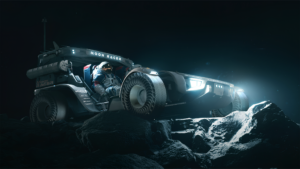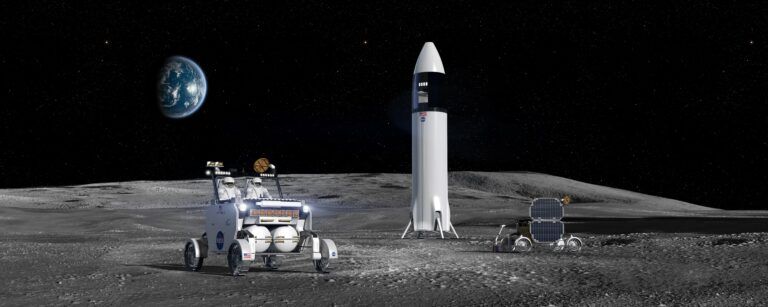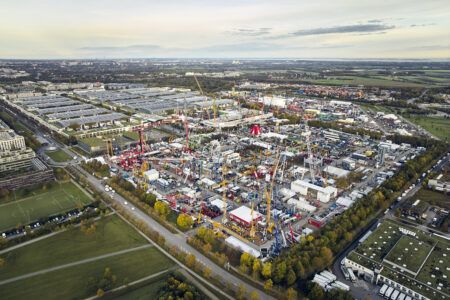With NASA aiming to land a crew on the moon by the end of 2026, the race is on to build the hardware to support humans in a hostile enviroment including electric, off-highway rovers, scheduled to be taken there in 2030. Here we take a look at three of the vehicle designs in the running and find out about new technology that could one day find its way into everyday machines on earth
NASA’s Artemis missions will land the first woman and first person of colour on the Moon in a programme to establish a long-term presence there. This is part of NASA’s Moon to Mars Architecture which will see humans return to the Moon for the first time since 1972. Nine LTV proposals have been narrowed down to three, one of which will be chosen to fulfil a 10-year contract. The Moon will be used as a test ground to validate exploration systems for future Mars missions with the ultimate goal to reach Mars.
The first stages of this scheme requires the development of an LTV to support scientific discovery around the lunar south pole. The three companies in the running for the contract are Intuitive Machines, Lunar Outpost and Venturi Astrolab.
Although the focus of the Moon to Mars Architecture is scientific exploration, the programme will support the development of the lunar economy. This means NASA will use the LTV for some months of the year and in the others, it encourages the winning contractor to pursue commercial activities. Steve Munday, LTV project manager at NASA Johnson Space Center, explains, “We are procuring the LTV as a service. Rather than building, buying or owning it as we did for Apollo, we’re basically renting it. The contractor remains the owner of the LTV. You can think of it as our astronauts arriving on Artemis landers and their Uber ride is there waiting for them.”
Each firm’s proposal must comply with minimum requirements set out by NASA which include a minimum operational time of eight hours before the vehicle needs recharging and a range of 20km without recharging. The battery-powered Lunar Roving Vehicles (LRV) used in the early 1970s on Apollo 15, 16 and 17 were driven for no more than 36km and had no way to recharge on the Moon. The LRV had a range of 100km, but given the Apollo missions were so short, there was no opportunity to fully deplete the batteries.
Aside from the requirement to meet operational parameters, each proposer is free to design a solution for NASA’s criteria as they see fit. Hence, the three proposed LTVs feature very different interpretations of the brief while sharing common features that would be suited to the lunar environment.

Lunar Outpost
Lunar Outpost’s LTV project is called Lunar Dawn. This is a joint effort between Lunar Outpost, Lockheed Martin, General Motors, Goodyear, and MDA Space. The LTV has an electric powertrain with a solar array to recharge the vehicle on the Moon.
This uses General Motors’ Ultium lithum battery technology, which uses nickel-cobalt-manganese-aluminum (NCMA) cathodes, and is expected to exceed NASA’s 20km range target.
“It’s an extremely high- performance battery that gives our vehicle really good energy storage capabilities on the Moon,” says Dr Forrest Meyen, chief strategy officer for Lunar Outpost. “Power itself is not only something that enables mobility but allows us to manage the thermal state of the vehicle to survive some of these extreme temperatures that we see on the Moon.”
As the Moon has an exosphere instead of atmosphere, the sun, or lack of sun, can result in temperatures ranging from -200°C to 100°C (-318°F to 212°F). This means as well as vehicle systems, payloads must be thermally regulated. “We like to call our LTV a space truck,” says Dr Meyen. “In the truck bed we have slots called the universal payload adapter system (UPAS) and each of these slots has interfaces for power and data. That’s how payloads can stay warm, transmit data and collect information.”
Equipment to collect samples is fitted at the rear of the vehicle. “We have a large robotic arm built by MDA and this is used to interact with the surface, look at samples, carry cameras and scientific instruments closer to the surface, as well as to unload and load commercial payloads,” says Meyen.
Lunar Outpost is in discussions with three types of commercial customers. Firstly, scientists outside of NASA are interested in samples and Moon exploration. Secondly, other activities centre around accessing resources. Lastly, Lunar Outpost anticipates customers investing in lunar infrastructure projects. “This vehicle is optimised for offloading large pieces of infrastructure, setting them up and maintaining them,” says Meyen. “This could be any sort of lunar surface infrastructure you could imagine.” For instance, power generation equipment, comms infrastructure or surface habitats.
Whilst some of these activities will be completed with astronauts, a large part of the LTV’s exploration is expected to happen autonomously. NASA’s requirements state the vehicle must be able to drive itself and be teleoperated from earth.
Lunar Outpost will equip its LTV with several sensors to give the vehicle autonomous functionality. “They are similar to those used on autonomous cars,” says Dr Meyen. “They are spaceflight hardened and optimised for working in the lunar environment where you have high-contrast lighting and permanently shadowed regions with almost no lighting, other than potentially earth shine and starlight.” In places where there is light, “shadows are long and very sharp. Most of the time when we’re in sunlight, we expect the sun to be between two to 15 degrees above the horizon,” adds Dr Meyen.
The lighting conditions and exosphere can make it challenging for astronauts to perceive the terrain ahead. “It’s sometimes very difficult on the surface of the Moon to see how far away things are because you don’t have any atmospheric effects that cause things farther away to get blurry or hazy. There’s no real indicators of depth and distance so our sensors provide information to the astronauts on those hazards and where they are,” says Dr Meyen.
When astronauts are not driving, Lunar Outpost will be able to switch into autonomous or remote driving modes from earth. “When it’s autonomous the rover itself will be making decisions on its path and location,” says Dr Meyen. “We also have the ability to teleoperate it and that’s something we’ve already demonstrated, driving our rovers in Australia from Colorado.”
Some of this whole vehicle testing can be completed on Earth and since there will be very limited astronaut time to address any maintenance issues on the Moon, the LTV must be extremely robust. “There’s a lot of testing on exposing components to the lunar environment, using thermal vacuum chambers (TVAC) and dusty TVAC. This is important because lunar dust is highly abrasive so when we look at wear components, our goal is to get multiple times over the number of tests or cycles we would need on the Moon.”
For systems that need to be validated on the Moon, Lunar Outpost will be testing these on its other missions there. “Lunar outpost has four missions going to the Moon before this rover,” says Dr Meyen. “We’re flying to the Moon this year for Lunar Voyage 1, so we’ll be testing a lot of technologies on that. We’ll be testing stereo camera systems, different sorts of imaging and mapping technologies, and autonomy features that we’ll then roll into LTV. We’re going to burn down a lot of the risk and uncertainty actually on the surface of the Moon this year.”
“When it’s autonomous the rover itself will be making decisions on its path and location”
Intuitive Machines
Similarly, Intuitive Machines plans to use other lunar missions to support the development of its LTV. Trent Martin, senior vice president of Space Systems at Intuitive Machines, says, “Intuitive Machines is a cislunar company and we’ve already landed on the Moon once. We have multiple missions to the Moon, and we see lunar infrastructure and architecture as the basis of our company.”
Intuitive Machines’ LTV programme, Moon Racer, is being developed in collaboration with AVL, Boeing, Michelin, and Northrop Grumman. Unlike the other LTV proposals, the Moon Racer project includes a trailer. Intuitive Machines plans to send more than one LTV to the Moon along with potentially multiple trailers.
These will be transported to the Moon using the company’s Nova D cargo-class lunar lander which can launch and land up to 2,500kg. The LTV is expected to weigh around 800kg and be capable of carrying 400kg of crew and 400kg of payload, while the trailer will weigh around 50kg. “The trailers allow us to carry as much as 800kg of additional mass and put them in various places,” says Martin. “Our concept is if you’re building a base and you have a construction site, you’re probably going to need trailers that have power or communication systems.”
While the trailer provides a functional addition to the LTV when it is being towed, the team has greater plans for trailers to expand possibilities for more data collection. “The trailer concept allows us to deploy systems that the base will need, or to do additional science where maybe you go and set up a science platform on a distant ridge. Then come back and continue your activities with crew or continue activities with the robotic system while the science is still going on up on the ridge or down in a crater,” Martin says.
Like Lunar Outpost’s design, Intuitive Machines is using a battery electric powertrain, charged with solar cells. Martin says, “It’s like driving an electric car, that’s why we think the state of the [automotive] industry is at the perfect position to develop this kind of vehicle.” But regardless of advances in technology today, Intuitive Machines is planning ahead to future developments.

The Moon Racer LTV will have a modular design to allow it to be upgraded over time. “We don’t intend for this vehicle to operate for 10 years because it’s hard to get your car to run for 10 years without regular maintenance. We intend to have multiple vehicles that we take up over time so we can do regular maintenance and change systems.” This could include changing batteries or solar cells so as this technology improves, it will unlock new possibilities for the rover to travel further, faster and more efficiently.
In the meantime, protecting the LTV’s electronic systems is essential for the longevity of the vehicle. Martin explains, “The key for us is proper thermal management. This means providing power from our battery systems to keep things warm because it’s normally the cold temperatures that cause the most difficulty.”
Managing LTV systems is especially important when the vehicle is operating autonomously. Martin notes, “Processing capability and speed is the biggest challenge that we face. The computers that we can use on the Moon are not the same computers you can use on the earth. The radiation and temperature environments are harsher and more importantly, you need to be able to do that processing on location.”
To ensure the reliability of these technologies Intuitive Machines must go to greater lengths than typical earth-going vehicle testing and development. As well as building the LTV with robust components and systems that have already been proven in space, redundancies are the next way to boost reliability. This includes dissimilar redundant systems. “If you have one type of radio, you may put a different type of radio into the vehicle in case of the event that you have some kind of common failure on the first radio,” Martin explains. This kind of redundancy is particularly important for communications and sensor equipment.
Outside of its obligations to NASA, Intuitive Machines is fostering relationships with commercial clients. Interested parties so far include scientists, those looking to harvest resources and companies hoping to start manufacturing on the Moon. Martin says, “We’ve had interest from people wanting to build things out of regolith on the Moon, people that want to build unique products that can be built in 1/6 gravity but can’t be built in earth’s gravity.” Alongside getting things to the Moon, Intuitive Machines plans to offer its commercial clients return capabilities to bring back samples, materials or products found or created there.
This article was first published in the August issue of iVT International





